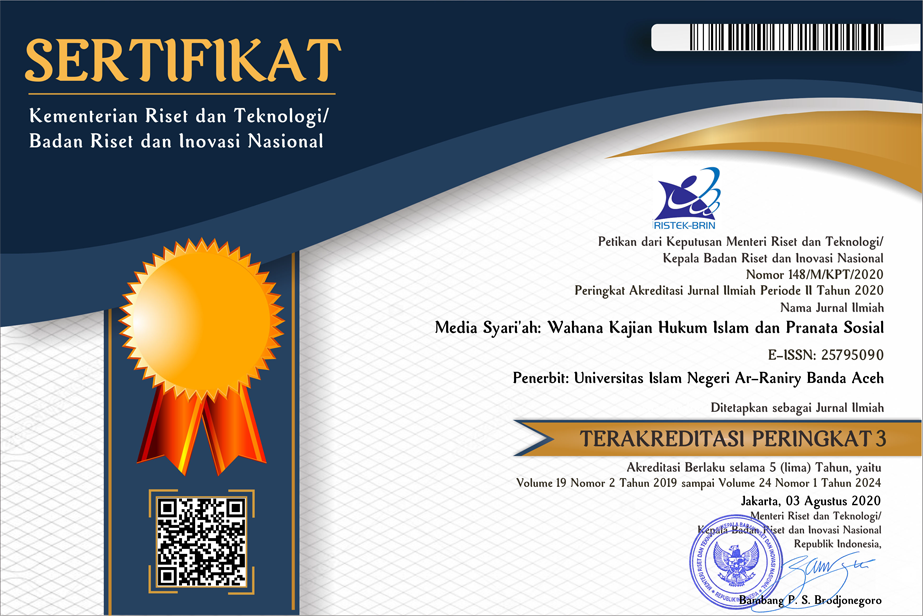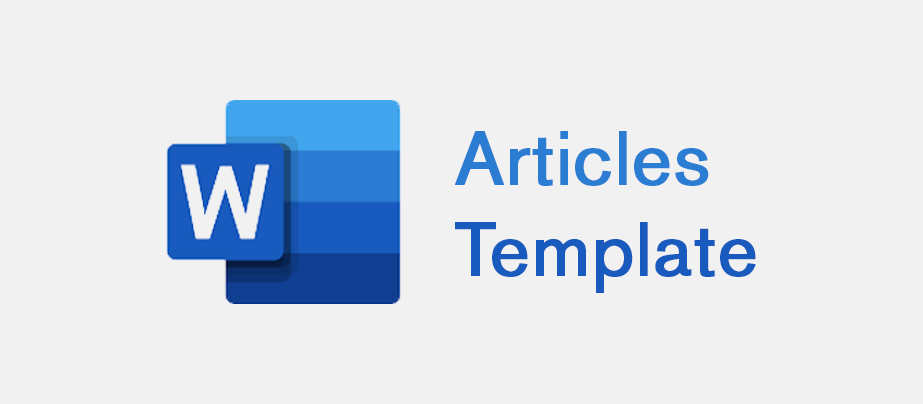Peran dan Fungsi Kelembagaan Mukim dalam Penyelesaian Perselisihan: Analisis Praktek Hukum Adat di Aceh
DOI:
https://doi.org/10.22373/jms.v19i2.2025Keywords:
Mukim, Qanun, customary law, Customary Institution, Dispute Resolution.Abstract
Mukim is one of the Acehnese customary institutions in charge of resolving disputes that occur in the community. Within Acehnese customary judicial process, the mukim is positioned at the second level after the gampong. One of the mukim's duties de jure, as stipulated in Article 4 letter (e) of Aceh Qanun No. 4/2003 on Mukim Government, is to provide judicial decisions in the event of customary disputes or cases and customary laws. However, the role of mukim has begun to decrease in terms of resolving community problems. The purpose of this study was to investigate the factors that influenced nonoptimal roles of the mukim, the mechanisms used by the mukim in resolving disputes within the Acehnese society, and the philosophical, juridical and sociological values of the dispute settlements implemented by the institutional mukim. The study used empirical legal method to describe the implementation of the laws on the mukim authority in resolving disputes. The study took place in five areas: Banda Aceh, Aceh Besar, Bireuen, Aceh Tengah, and Nagan Raya. The primary data came from interview and FGDs with Keuchik, Mukim, Police, NGOs, and academicians concerning on Aceh customary laws. The secondary data included primary, secondary, and tertiary legal materials. The primary legal material was the Law regulating the Mukim, the secondary ones came from documentation study including books, journals, and research findings in the library on mukim, and the tertiary ones were from dictionaries and encyclopedias. The results of the study showed that the factors causing nonoptimal roles of the mukim included the human resources, poor training and development, lack of funding, and conflict in Aceh. The customary court at the mukim level had similar ways of resolution as that at the gampong. Likewise, the mechanisms to settle were the same i.e., mutual deliberation and mediation. The difference laid only in the procedural systems. In terms of the philosophical values, both mukim and gampong used the win-win solution principle, creating a harmony between the parties involved, saving time, saving cost, having a moment of connecting kinship between people (silaturahim), and following the teaching of Islam. These findings are hoped to provide insights to people to promote dispute settlement through customary institutions i.e., mukim and gampong prior to taking the cases to the police. It is also hoped that the police will not follow-up the case reports that do not use the customary procedures, and that the executive and legislative institutions can initiate a provincial Qanun which is oriented towards the mukim empowerment proportionally and professionally. Further, socialization on such customary practices should be done at every level of the community in order for the public to be more aware of the mukim’s dispute resolution.References
A.Husein Almujahid, Thoha dan A. Atho’illah Fathoni Alkhalil. 2013. Kamus Akbar Bahasa Arab, Jakarta: Gema Insani.
Alfian dkk., T. Ibrahim. 1978. Adat Istiadat Daerah Provinsi Daerah Istimewa Aceh, Banda Aceh: Proyek Penelitian dan Pencatatan Kebudayaan Daerah.
Bakar (et.al.), Aboe. 1985. Kamus Aceh Indonesia 2, Seri M-Y, Jakarta: Pusat Pembinaan dan Pengembangan Bahasa Departemen Pendidikan dan Kebudayaan.
Bakhri, Syaiful. 2015. Sistem Peradilan Pidana Indonesia dalam Perspektif Pembaharuan, Teori dan Praktik Peradilan, Cet. 2, Yogyakarta: Pustaka Pelajar.
Dewi, Erna, Firganefi. 2014. Sistem Peradilan Pidana (Dinamika dan Perkembangan), ed. 2, Yogyakarta: Graha Ilmu.
Hugrange, Snock. 1985. The Achehnese,diterjemahkan Singarimbun (et.al.), Aceh Dimata Kolonialis, Yayasan Soko Guru, Jakarta.
Husin, Taqwaddin. 2013. Kapita Selekta Hukum Adat Aceh dan Qanun Wali Nanggroe, (Banda Aceh: Bandar Publishing.
Hutahaean, Bilher. Penerapan Sanksi Pidana Bagi Pelaku Tindak Pidana Anak Kajian Putusan Nomor 50/Pid.B/2009/PN-Btg, Jurnal Yudisial, vol. 6, No. 1, Jakarta: Komisi Yudisial Republik Indonesia, 2013.
Isa Sulaiman, M.. 2001. Tinjauan Historis Peradilan Adat di Aceh, dalam M. Isa Sulaiman (ed.), “Pedoman Adat Aceh: Peradilan dan Hukum Adat, Banda Aceh: Lembaga Adat dan Kebudayaan Aceh (LAKA).
Ismail, Badruzzaman. 2012. Pedoman Peradilan Adat di Aceh Untuk Peradilan Adat yang Adil dan Akuntabel, (Banda Aceh: MAA-BAPPENAS.
Jamin, Mohammad. 2014. Peradilan Adat Pergeseran Politik Hukum, Perspektif Undang-Undang Otomi Khusus Papua, Yogyakarta: Graha Ilmu.
Juned, T. M. 2001. Penerapan Sistem dan Asas-asas Peradilan Hukum Adat dalam Penyelesaian Perkara, dalam M. Isa Sulaiman (ed.), “Pedoman Adat Aceh: Peradilan dan Hukum Adat, Banda Aceh: Lembaga Adat dan Kebudayaan Aceh (LAKA).
Kamus Besar Bahasa Indonesia. 1995. Jakarta: Depatemen Pendidikan dan Kebudayaan, Balai Pustaka.
Prakoso, Abintoro. 2013. Pembaharuan Sistem Peradilan Pidana Anak, Surabaya: Laksbang Grafika.
S. Atalim, Keadilan Restoratif sebagai Kritik Inheren Terhadap Pengadilan Legal Konvensional, Jurnal Rechtcinding, vol. 2, Jakarta: Pusat Penelitian dan Pengembangan Sistem Hukum Nasional.
Syafi’i, Imam. 2008. Ringkasan Kitab Al-Umm, terj. Mohammad Yasir Abd Muthalib, Andi Arlin, cet. 6, jil. 1, Jakarta: Pustaka Azzam.
Tim Peneliti IAIN Ar-Raniry & Biro Keistimewaan Aceh Provinsi NAD. 2006. Kelembagaan Adat Provinsi Nanggroe Aceh Darussalam, Banda Aceh: Ar-Raniry Press.
Tripa, Sulaiman. 2015. Sejarah Perlawanan Mukim Berdaulat, dalam Adat Berdaulat Melawan Kapitalisme di Aceh, Yogyakarta: Insist Press.
Yunus, Muhammad. 1989. Kamus Arab-Indonesia, Jakarta: Hidakarya Agung.
Downloads
Published
Issue
Section
License
MEDIA SYARI'AH: Wahana Kajian Hukum Islam dan Pranata Sosial has CC-BY-SA or an equivalent license as the optimal license for the publication, distribution, use, and reuse of scholarly work. Authors who publish with this journal agree to the following terms:
1. Authors retain copyright and grant the journal right of first publication with the work simultaneously licensed under a Creative Commons Attribution-ShareAlike 4.0 International License that allows others to share the work with an acknowledgment of the work's authorship and initial publication in this journal.
2. Authors are able to enter into separate, additional contractual arrangements for the non-exclusive distribution of the journal's published version of the work (e.g., post it to an institutional repository or publish it in a book), with an acknowledgment of its initial publication in this journal.
3. Authors are permitted and encouraged to post their work online (e.g., in institutional repositories or on their website) prior to and during the submission process, as it can lead to productive exchanges, as well as earlier and greater citation of published work (See The Effect of Open Access).
You are free to:
Share — copy and redistribute the material in any medium or format.
Adapt — remix, transform, and build upon the material for any purpose, even commercially.
The licensor cannot revoke these freedoms as long as you follow the license terms.
All papers published in MEDIA SYARI'AH: Wahana Kajian Hukum Islam dan Pranata Sosial are licensed under a Creative Commons Attribution-ShareAlike 4.0 International License.



.png)


.png)
.png)
.png)



